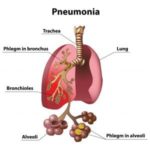 Pneumonia is a pox on the house of public health worldwide – especially where children are concerned. In 2017 alone, the disease killed 2.56 million people worldwide. Of these, almost one-third were children aged under five years making pneumonia the leading cause of death for kids in that age demographic.
Pneumonia is a pox on the house of public health worldwide – especially where children are concerned. In 2017 alone, the disease killed 2.56 million people worldwide. Of these, almost one-third were children aged under five years making pneumonia the leading cause of death for kids in that age demographic.
India feels the brunt of the disease acutely. The impact on child health is particularly stunning. As reported by Health Issues India on World Pneumonia Day last year
“Officials warn that the disease represents a ‘forgotten epidemic’. UNICEF reminded us that every 39 seconds, a child loses their life to pneumonia worldwide. “This is a forgotten global epidemic that demands an urgent international response,” Save the Children chief executive Kevin Watkins commented on the observance. “Millions of children are dying for want of vaccines, affordable antibiotics, and routine oxygen treatment. The pneumonia crisis is a symptom of neglect and indefensible inequalities in access to healthcare.””
We observe World Pneumonia Day 2020 today, at a time when the world grapples with the COVID-19 pandemic. COVID-19 – the disease caused by severe acute respiratory syndrome coronavirus 2 (SARS-CoV-2) or, simply, coronavirus – has ravaged the globe at a brisk clip throughout the year. India is well-acquainted with the burden of COVID-19, being the second worst-affected country in terms of the number of confirmed infections at the time of writing.
During the age of COVID-19, pneumonia’s importance has been heightened. WebMD observes that “most people who get COVID-19 have mild or moderate symptoms like coughing, a fever, and shortness of breath. But some who catch the new coronavirus get severe pneumonia in both lungs. COVID-19 pneumonia is a serious illness that can be deadly.”
Pneumonia, as explained by the World Health Organization, “is a form of acute respiratory infection that affects the lungs. The lungs are made up of small sacs called alveoli, which fill with air when a healthy person breathes. When an individual has pneumonia, the alveoli are filled with pus and fluid, which makes breathing painful and limits oxygen intake.”
As it pertains to COVID-19, pneumonia is a serious complication. A British Medical Journal paper published earlier this year noted “the long-term complications of COVID-19 pneumonia are starting to emerge but data from previous coronavirus outbreaks such as severe acute respiratory syndrome (SARS) and Middle East respiratory syndrome (MERS) suggest that some patients will experience long-term respiratory complications of the infection.
“With the pattern of thoracic imaging abnormalities and growing clinical experience, it is envisaged that interstitial lung disease and pulmonary vascular disease are likely to be the most important respiratory complications.”
World Pneumonia Day this year, as Stop Pneumonia points out, means that “pneumonia [already] the single biggest infectious killer of adults and children – claiming the lives of 2.5 million, including 672,000 children, in 2019….COVID-19 could add 1.9 million to the death toll this year. This could increase ‘all-cause’ pneumonia deaths by more than 75 percent. No other infection causes this burden of death. Disruptions to healthcare services are estimated to cause up to an additional 2.3 million child deaths – 35 percent from pneumonia and newborn sepsis.”
For India, a country who can anticipate 1.7 million child deaths due to pneumonia by 2030, the risks of its ongoing pneumonia crisis side-by-side with its substantial burden of COVID-19 are patent. Vaccination against the disease is imperative to control it. The alternative is the continued situation of massive loss of life – to the tune of one child under five every two minutes.
It heightens, for the Union Government, the importance of Stop Pneumonia’s call. “We are calling on governments and other stakeholders to ensure that the massive effort to control the pandemic contributes to reducing ‘all-cause’ respiratory infections and deaths among both children and adults for the long term,” they said.



